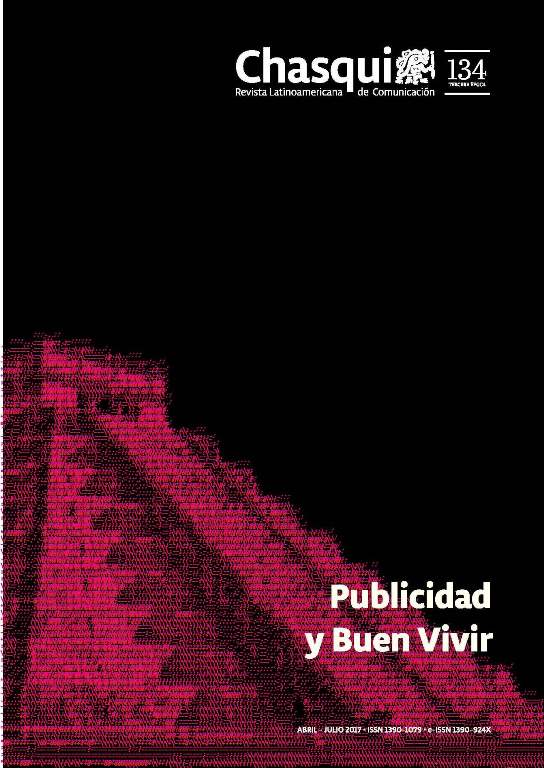Internet access in high school students in Ecuador
DOI:
https://doi.org/10.16921/chasqui.v0i134.2722Keywords:
media, digital divide, internet access, digital literacyAbstract
In Ecuador and other Latin American countries, although the digital divide referring to access decreases, the gap on more complex digital literacy levels persists. This study, based on a random and stratified sample of 3,754 by provinces, representing high school students in Ecuador, aims at: a) identifying their Internet access capabilities (material, operational, informational knowledge and expressive use), and b) recognizing the influence of socio-demographic issues on different kind of access. The results show high levels in material and operational Internet access, in informational knowledge, and lack of expressive use. The influence of socio-demographic factors decreases at higher levels of access.References
Aguaded-Gómez, I., Tirado-Morueta, R., & Hernando-Gómez, Á. (2014). Media competence in adult citizens in Andalusia, Spain. Information, Communication & Society, 18 (6), 659-679. Disponible en http://bit.ly/2n0myQE.
Barzilai-Nahon, K. (2006). Gaps and bits: Conceptualizing measurements for digital divide/s. The Information Society, 22 (5), 269-278. Disponible en http://bit.ly/2nfOyS5.
Bilbao-Osorio, B.A., Dutta, S., & Lanvin, B. (2014). The Global Information Technology Report. Geneva: WEFBlank, G., & Groselj, D. (2014). Dimensions of Internet use: Amount, variety, and types. Information, Communication & Society, 17(4), 417-435. Disponible en http://bit.ly/2mArL6i.
Brundidge, J., & Rice, R. E. (2009). Political engagement online: Do the information rich get richer and the like-minded more similar. Routledge handbook of Internet politics, 144-156.
Buckingham, D. (2007). Media education goes digital: an introduction. Learning, Media and Technology, 32(2), 111-119. Disponible en http://bit.ly/2oeMau8.
Chadwick, A. (2013). The hybrid media system: Politics and power. Oxford University Press.
Cheong, P. H. (2007). Gender and perceived Internet efficacy: Examining secondary digital divide issues in Singapore. Women's Studies in Communication, 30(2), 205-228. Disponible en http://bit.ly/2nlyYpQ.
Gunkel, D. J. (2003) Second thoughts: Toward a critique of the digital divide. New Media & Society, 5, 4.
Haddon, L. (2000). Social exclusion and information and communication technologies lessons from studies of single parents and the young elderly. New Media & Society, 2(4), 387-406.
Haight, M.; Quan-Haase, A. & Corbett, B. A. (2014). Revisiting the digital divide in Canada: The impact of demographic factors on access to the Internet, level of online activity and social networking site usage. Information Communication & Society, 17 (4), Disponible en 503-519. http://bit.ly/2n0yhyC.
Harambam, J.; Aupers, S. & Houtman, D. (2013). The contentious gap: From digital divide to cultural beliefs about online interactions. Information Communication & Society, 16(7), 1093-1114. Disponible en http://bit.ly/2n0yiT7.
Hargittai, E. (2002). Second-level digital divide: Differences in people´s online skills. First Monday, 7(4).
Hargittai, E. & Hinnant, A. (2008). Digital Inequality Differences in Young Adults' Use of the Internet. Communication Research, 35(5), 602-621. Disponible en http://bit.ly/2oeKL6W.
ITU (2014). Measuring the Information Society Report. International Telecommunications Union. Disponible en http://bit.ly/2nRe0jU.
Kaiser, H. F. (1960). The application of electronic computers to factor analysis. Educational and psychological measurement, 20, 141-151. Disponible en http://bit.ly/2nRaGVX.
Kuttan, A. P. & Peters, L. (2003). From digital divide to digital opportunity. Scarecrow Press, Inc.
Livingstone, S. & Helsper, E. (2007). Gradations in digital inclusion: Children, young people and the digital divide. New Media & Society, 9(4), 671-696. Disponible en http://bit.ly/2mAvsZX.
Newhagen, J. E. & Bucy, E. P. (2004). Routes to media access. Media access: Social and psychological dimensions of new technology use, 3-23.
Riggins, F. J. & Dewan, S. (2005). The digital divide: Current and future research directions. Journal of the Association for Information Systems, 6(12), 4.
Servon, L. J. (2008). Bridging the digital divide: Technology, community and public policy. John Wiley & Sons.
Van Deursen, A.J. & Helsper, E.J. (2015). A nuanced understanding of Internet use and non-use amongst the elderly. European Journal of Communication, 30(2), 171-187. http://bit.ly/2nlP96l.
Van Deursen, A. J. & Van Dijk, J. A. (2015). Toward a Multifaceted Model of Internet Access for Understanding Digital Divides: An Empirical Investigation. The Information Society, 31(5), 379-391.
Van Deursen, A. J.; Van Dijk, J. A. & Ten Klooster, P. M. (2015). Increasing inequalities in what we do online: A longitudinal cross sectional analysis of Internet activities among the Dutch population (2010 to 2013) over gender, age, education, and income. Telematics and informatics, 32(2), 259-272.
Van Dijk, J. (2012). The evolution of the digital divide: The digital divide turns to inequality of skills and usage. Bus, Crompton, Hildebrandt & Metakides (eds.), Digital Enlightenment Yearbook, 2012, 57-75.
Warschauer, M. (2004). Technology and social inclusion: Rethinking the digital divide MIT press.
Weber, M. (1978). Economy and society: An outline of interpretive sociology. University of California Press.
Witte, J. C. & Mannon, S. E. (2010). The internet and social inequalitites. Londres: Routledge.
Zhang, X. (2013). Income disparity and digital divide: The internet consumption model and cross-country empirical research. Telecommunications Policy, 37(6-7), 515-529. DOI: 10.1016/j.telpol.2012.12.011.
Downloads
Published
Issue
Section
License
- Authors retain copyright and grant the journal right of first publication with the work simultaneously licensed under a Creative Commons Attribution-NoDerivs License (CC BY-ND) that allows others to share the work with an acknowledgement of the work's authorship and initial publication in this journal.
- Authors are able to enter into separate, additional contractual arrangements for the non-exclusive distribution of the journal's published version of the work (e.g., post it to an institutional repository or publish it in a book), with an acknowledgement of its initial publication in this journal.
- Authors are permitted and encouraged to post their work online.

